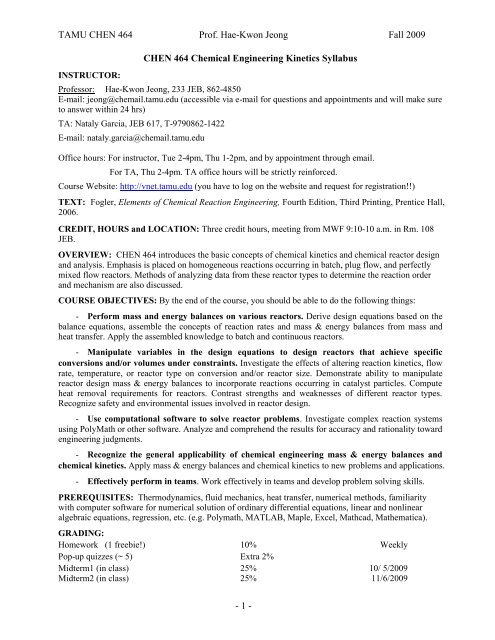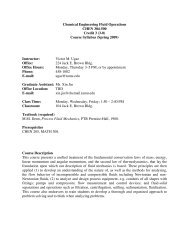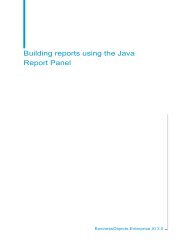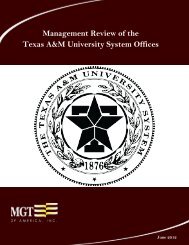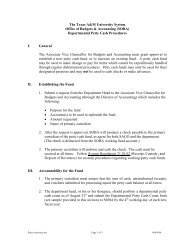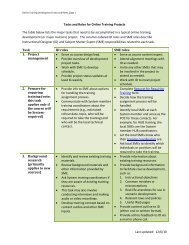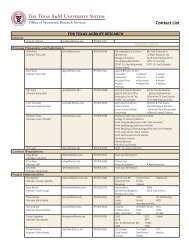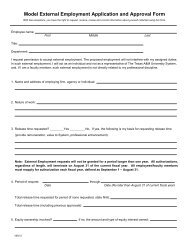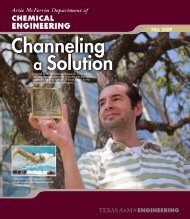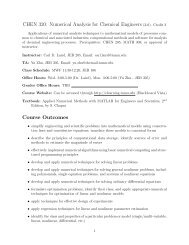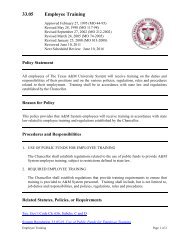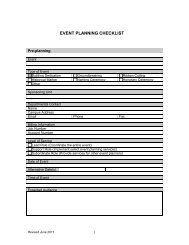CHEN 464 - Department of Chemical Engineering - Texas A&M ...
CHEN 464 - Department of Chemical Engineering - Texas A&M ...
CHEN 464 - Department of Chemical Engineering - Texas A&M ...
You also want an ePaper? Increase the reach of your titles
YUMPU automatically turns print PDFs into web optimized ePapers that Google loves.
TAMU <strong>CHEN</strong> <strong>464</strong> Pr<strong>of</strong>. Hae-Kwon Jeong Fall 2009INSTRUCTOR:<strong>CHEN</strong> <strong>464</strong> <strong>Chemical</strong> <strong>Engineering</strong> Kinetics SyllabusPr<strong>of</strong>essor: Hae-Kwon Jeong, 233 JEB, 862-4850E-mail: jeong@chemail.tamu.edu (accessible via e-mail for questions and appointments and will make sureto answer within 24 hrs)TA: Nataly Garcia, JEB 617, T-9790862-1422E-mail: nataly.garcia@chemail.tamu.eduOffice hours: For instructor, Tue 2-4pm, Thu 1-2pm, and by appointment through email.For TA, Thu 2-4pm. TA <strong>of</strong>fice hours will be strictly reinforced.Course Website: http://vnet.tamu.edu (you have to log on the website and request for registration!!)TEXT: Fogler, Elements <strong>of</strong> <strong>Chemical</strong> Reaction <strong>Engineering</strong>, Fourth Edition, Third Printing, Prentice Hall,2006.CREDIT, HOURS and LOCATION: Three credit hours, meeting from MWF 9:10-10 a.m. in Rm. 108JEB.OVERVIEW: <strong>CHEN</strong> <strong>464</strong> introduces the basic concepts <strong>of</strong> chemical kinetics and chemical reactor designand analysis. Emphasis is placed on homogeneous reactions occurring in batch, plug flow, and perfectlymixed flow reactors. Methods <strong>of</strong> analyzing data from these reactor types to determine the reaction orderand mechanism are also discussed.COURSE OBJECTIVES: By the end <strong>of</strong> the course, you should be able to do the following things:- Perform mass and energy balances on various reactors. Derive design equations based on thebalance equations, assemble the concepts <strong>of</strong> reaction rates and mass & energy balances from mass andheat transfer. Apply the assembled knowledge to batch and continuous reactors.- Manipulate variables in the design equations to design reactors that achieve specificconversions and/or volumes under constraints. Investigate the effects <strong>of</strong> altering reaction kinetics, flowrate, temperature, or reactor type on conversion and/or reactor size. Demonstrate ability to manipulatereactor design mass & energy balances to incorporate reactions occurring in catalyst particles. Computeheat removal requirements for reactors. Contrast strengths and weaknesses <strong>of</strong> different reactor types.Recognize safety and environmental issues involved in reactor design.- Use computational s<strong>of</strong>tware to solve reactor problems. Investigate complex reaction systemsusing PolyMath or other s<strong>of</strong>tware. Analyze and comprehend the results for accuracy and rationality towardengineering judgments.- Recognize the general applicability <strong>of</strong> chemical engineering mass & energy balances andchemical kinetics. Apply mass & energy balances and chemical kinetics to new problems and applications.- Effectively perform in teams. Work effectively in teams and develop problem solving skills.PREREQUISITES: Thermodynamics, fluid mechanics, heat transfer, numerical methods, familiaritywith computer s<strong>of</strong>tware for numerical solution <strong>of</strong> ordinary differential equations, linear and nonlinearalgebraic equations, regression, etc. (e.g. Polymath, MATLAB, Maple, Excel, Mathcad, Mathematica).GRADING:Homework (1 freebie!) 10% WeeklyPop-up quizzes (~ 5) Extra 2%Midterm1 (in class) 25% 10/ 5/2009Midterm2 (in class) 25% 11/6/2009- 1 -
TAMU <strong>CHEN</strong> <strong>464</strong> Pr<strong>of</strong>. Hae-Kwon Jeong Fall 2009Final exam 40% 12/14/ 2009I will assign grades at the end <strong>of</strong> the course based on your average. Although the cut<strong>of</strong>fs will bedetermined based on the class distribution, the following can be guaranteed:> 90 will receive an A> 80 will receive at least a B> 70 will receive at least a CRegrading: If you believe that a homework exercise or an exam has been graded incorrectly, see thepr<strong>of</strong>essor within one week after the work has been handed back. Write out on a separate sheet <strong>of</strong>paper what you believe to be in error.POLICY ISSUES:1. The final is cumulative in this course2. Make-up exams will only be given in the case <strong>of</strong> a well-documented emergency.3. Attendance is strongly recommended though not enforced. In case you must be excused,please let me know in advance.4. Out <strong>of</strong> courtesy to me and your fellow students, PLEASE come to class on time and pleaseturn <strong>of</strong>f cell phones or mute the ringer!HOMEWORK:(1) The weekly homework will be due at the beginning <strong>of</strong> class on the day it is DUE. Typicallyyou will have a new homework on every Friday and the due is the next Friday. Latehomework will be docked 20%, unless you have a Dean's Excuse.(2) Homework may be handwritten neatly. Use ink or dark pencil. The following items are notacceptable: very light pencil, writing on both sides <strong>of</strong> the paper, untrimmed pages torn from spiralnotebooks, pages paper-clipped or folded together.(3) You are to make a group <strong>of</strong> three students <strong>of</strong> your own choice. However, each student mustbe able to solve every homework.(4) Solutions for the homework, as well as copies <strong>of</strong> lecture notes and examples, will be on thewebsite (http://vnet.tamu.edu) Check Weekly!HOMEWORK HINTS:(1) There will be roughly ~ 10 homeworks given through the semester. Homework assignments mustbe done in groups <strong>of</strong> three people, with one paper handed in per group per assignment. Each member <strong>of</strong>the team will receive the same grade for each assignment. Please see the Teamwork Policy andExpectations section <strong>of</strong> the syllabus for more details.(2) TRY doing the homework BEFORE coming to the <strong>of</strong>fice hours. You'll get a lot more out <strong>of</strong> it ifyou do.(3) BTW - Copying or slightly modifying old solution sets that may be out there looks rather obviousand silly to the reader. But much worse is the fact that you are not really learning the material that way, aswill become quite apparent at test time.(4) What I am really after is for you to learn from the homework. Remember exam problems aremore or less similar to the homework problems. Thus it is very important for you to be able to solvehomework problems if you want to do well in the exams.(5) The lowest grade on homework is thrown out, so don't sweat it if you miss one assignment. Butdon't blow <strong>of</strong>f the homework entirely.INSTRUCTOR COMMITMENT: You can expect me to be courteous, punctual, well organized, andprepared for lecture and other class activities; to answer questions clearly and in a non-negative fashion; to- 2 -
TAMU <strong>CHEN</strong> <strong>464</strong> Pr<strong>of</strong>. Hae-Kwon Jeong Fall 2009be available during <strong>of</strong>fice hours or to notify you beforehand if they are unable to keep them; and to ensureuniform and consistent grading according to the posted guidelines.- 3 -
TAMU <strong>CHEN</strong> <strong>464</strong> Pr<strong>of</strong>. Hae-Kwon Jeong Fall 2009Course Organization & Weekly Topics and AssignmentsWeek Topics ReadingAssignmentsWeek 1(8/31, 9/2, 4)Week 2(9/7, 9, 11)Week 3(9/14, 16, 18)Week 4(9/21, 23, 25)Week 5(9/28, 30, 10/2)Week 6(10/5, 7, 9)Week 7(10/12, 14, 16)Week 8(10/19, 21, 23)Week 9(10/26, 28, 30)Week 10(11/2, 4, 6)Week 11(11/9, 11, 13)Week 12(11/16, 18, 20)Week 13(11/23, 25, 27)Week 14(11/30, 12/2, 4)Week 15(12/7)Mole balances Chapter 1HomeworkAssignmentsand ExamHW#1 9/4Conversion and Reactor Sizing Chapter 2 HW#1 due 9/11HW#2 9/11Rate laws and stoichiometry Chapter 3 HW#2 due 9/18HW#3 9/18Isothermal Reactor Design Chapter 4 HW#3 due 9/25HW#4 9/25Isothermal Reactor Design Cont’d HW#4 due 10/2No HWCollection and analysis <strong>of</strong> rate data Chapter 5 Midterm I on10/5HW#5 10/9Multiple reactions Chapter 6 HW#5 due 10/16Reaction mechanisms, pathways,bioreactions, and bioreactorsSteady-state nonisothermal reactordesignSteady-state nonisothermal reactordesign Cont’dAIChE ConferenceAdsorption and Reaction on SolidSurfacesAdsorption and Reaction on SolidSurfaces Cont’dHW#6 10/16Chapter 7 HW#6 due 10/23HW#7 10/23Chapter 8 HW#7 due 10/30HW#8 10/30HW#8 due 11/6Midterm II on11/6HW#9 11/6No classChapter 10 HW#9 due 11/20HW#10 11/20Chapter 10 No Class 11/25& 11/27Reaction and Diffusion Chapter 11 HW#10 due 12/4Review- 4 -
TAMU <strong>CHEN</strong> <strong>464</strong> Pr<strong>of</strong>. Hae-Kwon Jeong Fall 2009Relationship <strong>of</strong> course objectives to ChE program outcomesCourse ObjectivesAn ability to perform mass and energy balances on reactors. 1, 3, 5, 11An ability to manipulate variables in the mass & energy balancesto design reactors that achieve specific conversions and safetyconstraints.An ability to use computational s<strong>of</strong>tware to analyze reactorproblems.An ability to recognize the general applicability <strong>of</strong> chemicalengineering mass & energy balances.ChE Program Outcomes1, 3, 5, 6, 8, 10, 111, 3, 5, 9, 101, 2, 5, 8, 9An ability to effectively perform in teams. 4, 6, 7, 8, 9- 5 -
TAMU <strong>CHEN</strong> <strong>464</strong> Pr<strong>of</strong>. Hae-Kwon Jeong Fall 2009Americans with Disabilities Act (ADA) Policy StatementThe Americans with Disabilities Act (ADA) is a federal anti-discrimination statute that providescomprehensive civil rights protection for persons with disabilities. Among other things, thislegislation requires that all students with disabilities be guaranteed a learning environment thatprovides for reasonable accommodation <strong>of</strong> their disabilities. If you believe you have a disabilityrequiring an accommodation, please contact Disability Services, in Cain Hall, Room B118, or call845-1637. For additional information visit http://disability.tamu.edu.Academic Integrity StatementAggie Honor Code: “An Aggie does not lie, cheat, or steal or tolerate those who do.”Upon accepting admission to <strong>Texas</strong> A&M University, a student immediately assumes acommitment to uphold the Honor Code, to accept responsibility for learning and to follow thephilosophy and rules <strong>of</strong> the Honor System. Students will be required to state their commitment onexaminations, research papers, and other academic work. Ignorance <strong>of</strong> the rules does not excludeany member <strong>of</strong> the <strong>Texas</strong> A&M University community from the requirements or the processes <strong>of</strong>the Honor System. For additional information please visit the website:www.tamu.edu/aggiehonor/.TEAM POLICIES AND EXPECTATIONSTEAM COMPOSITIONS AND RESPONSIBILITIES:You may form groups for team homework assignments <strong>of</strong> three persons. These groups are voluntary andmembers may be changed at any time given mutual consent. Your team will have a number <strong>of</strong>responsibilities as it completes problem and project assignments.1) Designate a coordinator, a recorder, and a monitor for each assignment, with each <strong>of</strong> these roleshaving responsibilities defined below. In teams <strong>of</strong> three, the same individual functions as monitor andchecker. Rotate these roles for every assignment. Agree on “Code <strong>of</strong> Cooperation”2) Agree on a common meeting time and what each member should have done before the meeting byway <strong>of</strong> preparation.3) Do the required individual preparation. Each team member should attempt to outline the solution<strong>of</strong> each problem before the team meets.4) Meet and work out the complete solutions to all assigned problems. Agree on next meeting timeand roles for next assignment.5) Review returned assignments. Make sure everyone understands why points were lost and how tocorrect errors.6) Consult with the instructor if a conflict arises that can't be worked through by the team.Omitting names from completed assignments.If a student's name appears on a solution set, it certifies that he/she has participated in solving EACH <strong>of</strong>the homework problems in a given problem sets. If a team member refuses to cooperate on an assignment,his/her name should not be included on the completed work.Group work isn't always easy: team members sometimes cannot prepare for or attend group sessionsbecause <strong>of</strong> other responsibilities, and conflicts <strong>of</strong>ten result from differing skill levels and work ethics.When teams work and communicate well, however, the benefits more than compensate for the difficulties.One way to improve the chances that a team will work well is to agree beforehand on what everyone onthe team expects from everyone else.- 6 -
TAMU <strong>CHEN</strong> <strong>464</strong> Pr<strong>of</strong>. Hae-Kwon Jeong Fall 2009- 7 -


